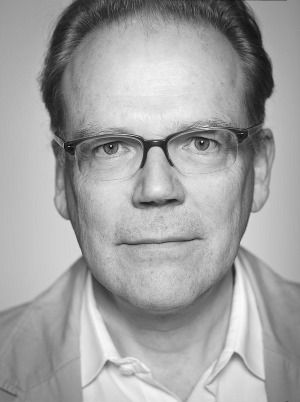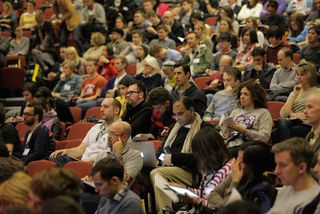Why you should get excited about TYPO Berlin
Next month Berlin will be hosting the annual TYPO conference; we ask programme director Jürgen Siebert why it's worth a visit.
We love a bit of typography on Creative Bloq, from discovering essential free fonts through to the serious business of the typography rules and terms that every designer must know. And if you're similarly typographically inclined, you'll be delighted to know that for three days in May, Berlin will be playing host to the annual TYPO conference, and Computer Arts will be there. We caught up with programme director Jürgen Siebert to find out why you should make the trip too.
What sets TYPO apart from the various other design conferences?
The DNA of TYPO was defined by a typographic publication that was published in the 1990s by FontShop and edited by Neville Brody and Jon Wozencroft: FUSE magazine.
That magazine was accompanied by a traveling conference, which was held in London, San Francisco and Berlin. FontShop loved to organize the FUSE 95 Berlin conference, and decided to continue with its own annual event. This was the birth of TYPO Berlin.
TYPO is a conference on contemporary trends in the field of communication design, with a focus on typography. Or, as our partners from TYPO London used to say: Design, Culture, and Society - with a little bit of kerning.
What's your background, and how did you get involved with TYPO?

I started my career in the field of design as a journalist in 1986, when I co-founded PAGE magazine in Hamburg. After five years as editor-in-chief I went to Berlin to join FSI FontShop International. There I established products like FUSE, the FontFont type foundry, FontBook (now an app for iPad and iPhone), and more.
In 1994 I became marketing officer of FontShop Germany. Today I'm the CEO of that company, program director of TYPO Berlin, San Francisco, and London, MC of CreativeMornings Berlin and several other events.
How integral is 'typography' for TYPO these days – to what extent is it important to give it a broader 'graphic design' appeal?
I think that typography is a much underestimated discipline in design. Type is essential: for brands, UX design, websites, print, etc. When we started with FontShop in 1989, we had to teach the benefits of typography to a brand new group of users, the desktop publishing kids. To get their interest you have to catch them with design stars, like Neville Brody, David Carson or Stefan Sagmeister.
Today, the situation seems to be similar in the field of screen typography, that is websites and apps. Once again a young new group of designers are confronted with the world of type (over 100,000 different fonts, compared to several hundred in 1989). The aim of our TYPO conferences is to teach the old typography skills, add new font technologies, and add some eye candy by celebrities to it.
Obviously Berlin is where it all began – what makes the San Francisco and London events different?
You're right, Berlin is a kind of blueprint for the TYPO product. We'll celebrate our 19th Berlin conference this year with a high degree of fine-tuning and experiences. Nonetheless other cities are different. I've learned that from Creative Mornings, for example.
TYPO London and TYPO San Francisco are both two-day-conferences, while Berlin runs three days. This has to do with the costs of living and the costs of working. For a professional designer, it's a critical decision to leave the office for two, three or even more days to visit a conference. The absence costs more money than travel, hotel plus the TYPO ticket all together.
While Berlin is famous for its festivals and its cultural stimulus, a three-day conference is much more accepted than in business metropoles. This is just one aspect of the differences. Others are: the quota of international and local speakers, the importance of student tickets, local sponsors, cooperation partners, etc.

TYPO London had a break in 2013 – are there any plans to resurrect it this year?
No, not 2014. We will be back in London in 2015 at the earliest.
There's always a broad theme that ties each TYPO event together. How did you decide on 'Roots' for this year?
Every year we have one or two dozen themes on the table, and at the end of a two-hour meeting one seems to fit the best. It's a question of zeitgeist, I think. But we should not overvalue these themes. They are helpful if you run a conference with a a static name like TYPO. But they are not essential for the quality of one specific conference.
Themes are firstly important for the speakers, who plan long-term. That's why we announce our theme a year beforehand (the theme of TYPO Berlin 2015 is Character, by the way). As soon as we've announced a theme, the first speakers write us that they have to say something that fits to the next theme.
Then, seven months before a TYPO conference, the theme gets important for the potential attendees. They have to convince their boss (or themselves) that Passion, Play, or Music might contain essential touch-points for their job.
How loose is the theme when it comes to briefing speakers?
We are very flexible with our themes, which might confuse some speakers. When I have the chance to get a world-famous designer to speak for the first time at a TYPO conference, the theme and his or her closeness to the theme aren't important at all. But when I receive a concept from an unknown speaker, I'll go into a discussion about the theme and need proof that the talk fulfills it.
Basically a theme is always helpful for our speakers to find a focal point. Some speakers talk an a variety of conferences, mainly with the same subject. In such cases, a theme help them to rethink some positions and give their presentations a special twist.
Who are your three main highlights from this year's line-up, and why?
I will not give you an answer to that, because I can't: Everyone is a highlight in our set-up. But I can tell you who I'm proud of because they are either new or don't do many conferences: Jim Avignon, Sarah Illenberger, and Gerrit Noordzij for example. Or Julia Hoffmann, Peter Bil'ak, and Tomas Mrazauskas.
Here are the reasons why. Jim: a unique multi-disciplinary artist from Berlin; Sarah: The best illustrator with a new perspective on seemingly familiar subjects; Gerrit: The best living type-design teacher, a legend; Julia: Ex-MoMA, Ex-Pentagram, now global creative director at Etsy – what a career; Peter Bil'ak: one of the best type designers of today, now also publisher of one of the best magazines; Tomas: The next big book designer, actual a book philosopher. It's hard for me to stop here.
What are you most excited about for this year's conference – and why should potential attendees share your excitement?
As the organizer of TYPO I'm excited that we still do one of the best (maybe THE best) design conference in Europe, although there are conferences nearly every week. This could only happen if we increase our quality from year to year.
Within 20 years we've made every possible mistake, and while we still work with the same team - that doesn't make any mistake twice - our attendees can experience a perfect event. Even the food gets better every year.
Finally, please sum up TYPO Berlin 2014 in five words...
Let's save 20 per cent, as I only need four words: Best TYPO Berlin ever!
TYPO takes place from 15–17 May at Haus der Kulteren der Welt in central Berlin. There's more information about the schedule and how to book here.
Words: Nick Carson Photography: Gerhard Kassner

Thank you for reading 5 articles this month* Join now for unlimited access
Enjoy your first month for just £1 / $1 / €1
*Read 5 free articles per month without a subscription

Join now for unlimited access
Try first month for just £1 / $1 / €1
Get the Creative Bloq Newsletter
Daily design news, reviews, how-tos and more, as picked by the editors.
The Creative Bloq team is made up of a group of design fans, and has changed and evolved since Creative Bloq began back in 2012. The current website team consists of eight full-time members of staff: Editor Georgia Coggan, Deputy Editor Rosie Hilder, Ecommerce Editor Beren Neale, Senior News Editor Daniel Piper, Editor, Digital Art and 3D Ian Dean, Tech Reviews Editor Erlingur Einarsson and Ecommerce Writer Beth Nicholls and Staff Writer Natalie Fear, as well as a roster of freelancers from around the world. The 3D World and ImagineFX magazine teams also pitch in, ensuring that content from 3D World and ImagineFX is represented on Creative Bloq.
